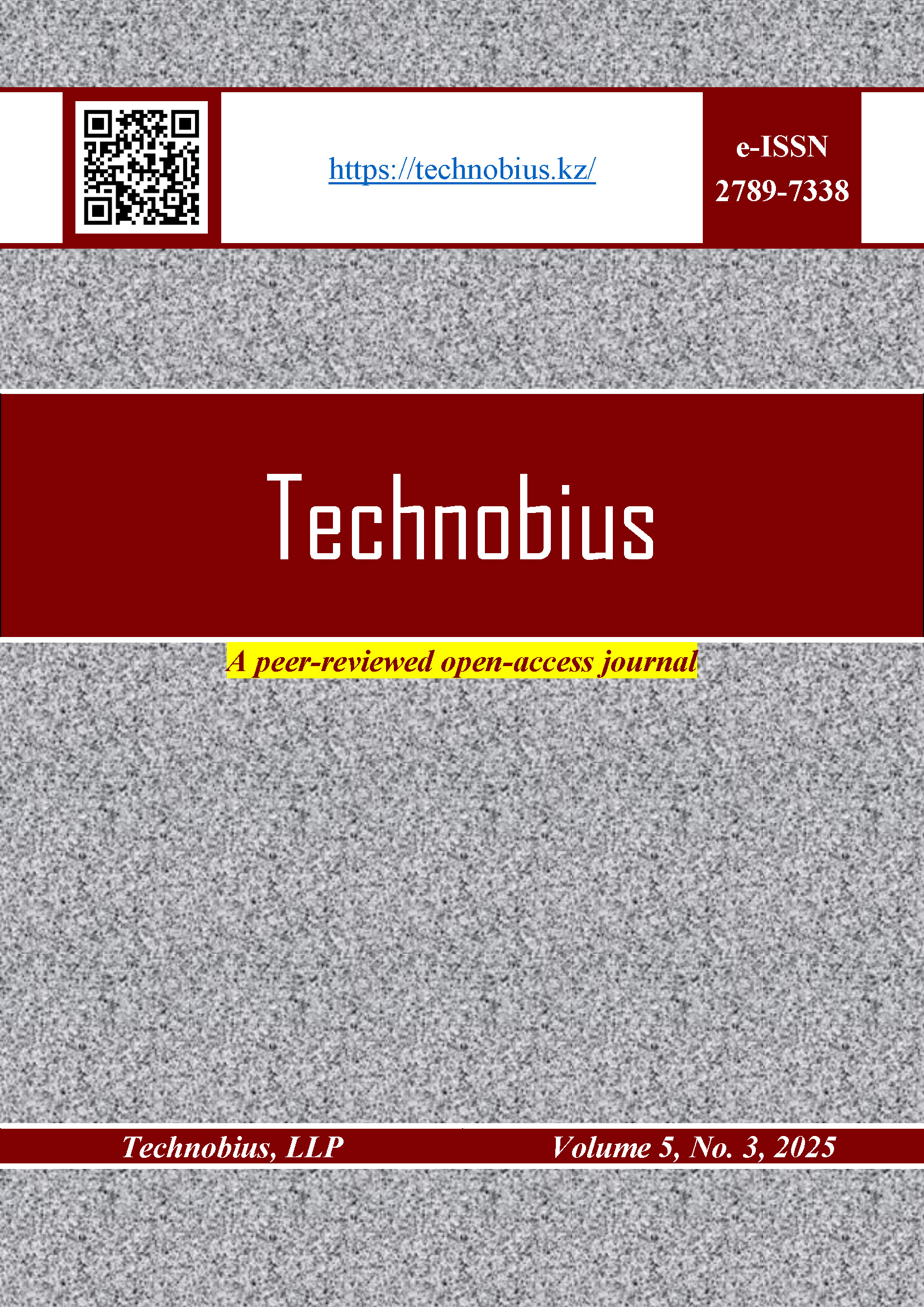Utilization of water treatment plant sludge in concrete mix
DOI:
https://doi.org/10.54355/tbus/5.3.2025.0083Keywords:
water treatment, settling tank, water supply, sludge, paving slab, strength, water absorption, permeabilityAbstract
This article presents the results of research on the processing of sludge generated at the Main Treatment Facilities (MTF) of Almaty, Kazakhstan, for use in concrete mixes. A nominal concrete mix composition was selected for sample production, consisting of Portland cement, crushed stone, sand, water, Interplast AT superplasticizer, and sludge from the horizontal settling tanks of the MTF. Samples were tested for compressive and flexural strength, water absorption, permeability, and density, revealing that replacing 5% sand with MTF sludge decreases compressive and flexural strengths at 28 days by 13.3% and 3.7%, respectively. In terms of water absorption, the best performance was observed in the sample containing 10% sludge from the MTF replacing part of the sand.
Downloads
Metrics
References
Almaty Su, “Technological Regulations for the Operation of the Main Water Treatment Facilities on the Bolshaya Almatinka River in Almaty City,” Almaty, 2015.
K. Ospanov, Ye. Kuldeyev, U. Onglassyn, S. Merkuryeva, and G. Mukhanova, “Selecting a flocculant for treating sludge from wastewater treatment plants in Almaty,” Water, land and forest resources, no. 4 (104), pp. 297–308, Dec. 2024, doi: 10.37884/4-2024/31. DOI: https://doi.org/10.37884/4-2024/31
K. Ospanov, E. Kuldeyev, D. Andraka, and M. Alzhigitova, “Pilot Study on the Possibility of Improving Water Treatment Sludge Management in Almaty,” Water (Basel), vol. 16, no. 19, p. 2849, Oct. 2024, doi: 10.3390/w16192849. DOI: https://doi.org/10.3390/w16192849
L. I. Qrenawi and F. K. J. Rabah, “Sludge management in water treatment plants: literature review,” Int J Environ Waste Manag, vol. 27, no. 1, p. 93, 2021, doi: 10.1504/IJEWM.2021.111909. DOI: https://doi.org/10.1504/IJEWM.2021.10033677
S. N. F. Zakaria, H. A. Aziz, Y.-T. Hung, M.-H. S. Wang, and L. K. Wang, “Treatment of Hazardous Sludge from Water and Wastewater Treatment Plants,” in Industrial Waste Engineering. Handbook of Environmental Engineering, vol. 28, Cham: Springer, 2023, pp. 1–41. doi: 10.1007/978-3-031-46747-9_1. DOI: https://doi.org/10.1007/978-3-031-46747-9_1
Z. He et al., “Recycling drinking water treatment sludge in construction and building materials: A review,” Science of The Total Environment, vol. 926, p. 171513, May 2024, doi: 10.1016/j.scitotenv.2024.171513. DOI: https://doi.org/10.1016/j.scitotenv.2024.171513
I. U. Aubakirova, “Use of sludge from water treatment plants in the production of building materials,” Water and Ecology, vol. 25, no. 4, pp. 32–37, 2020, doi: 10.23968/2305-3488.2020.25.4.32-37. DOI: https://doi.org/10.23968/2305-3488.2020.25.4.32-37
S. Ya. Davidov, R. A. Apakashev, and L. N. Oleynikova, “The variant of using precipitation water treatment for the production of building and ceramic materials,” NOVYE OGNEUPORY (NEW REFRACTORIES), no. 4, pp. 3–8, May 2023, doi: 10.17073/1683-4518-2023-4-3-8. DOI: https://doi.org/10.17073/1683-4518-2023-4-3-8
T. M. S. Agra, V. M. E. Lima, P. E. A. Basto, and A. A. Melo Neto, “Characterizing and processing a kaolinite-rich water treatment sludge for use as high-reactivity pozzolan in cement manufacturing,” Appl Clay Sci, vol. 236, p. 106870, May 2023, doi: 10.1016/j.clay.2023.106870. DOI: https://doi.org/10.1016/j.clay.2023.106870
C. Y. Ching, M. J. K. Bashir, N. Choon Aun, and M. A. A. Aldahdooh, “Sustainable production of concrete with treated alum sludge,” Constr Build Mater, vol. 282, p. 122703, May 2021, doi: 10.1016/j.conbuildmat.2021.122703. DOI: https://doi.org/10.1016/j.conbuildmat.2021.122703
R. Aline, M. Edy Lenin Tejeda, and B. Maria Eugenia Gimenez, “Reuse of water treatment plant sludge mixed with lateritic soil in geotechnical works,” Environmental Challenges, vol. 7, p. 100465, Apr. 2022, doi: 10.1016/j.envc.2022.100465. DOI: https://doi.org/10.1016/j.envc.2022.100465
J. Dragomirová, M. Palou, K. Gméling, V. Szilágyi, I. Harsányi, and L. Szentmiklósi, “Experimental Study of Selected Properties of Heavyweight Concrete Based on Analysis of Chemical Composition and Radioactive Elements of its Components,” Solid State Phenomena, vol. 321, pp. 113–118, Jul. 2021, doi: 10.4028/www.scientific.net/SSP.321.113. DOI: https://doi.org/10.4028/www.scientific.net/SSP.321.113
GOST 23732-2011. Water for Concrete and Mortar. Technical Specifications. Moscow, Russia, 2019, p. 18.
GOST 10180-2012. Concrete. Methods for Determining Strength Using Control Specimens. Moscow, Russia, 2018, p. 36.
GOST 12730.3-2020. Concrete. Method for Determining Water Absorption. Moscow, Russia, 2021, p. 14.
T. K. Akchurin, V. D. Tukhareli, and O. Yu. Pushkarskaya, “The Modifying Additive for Concrete Compositions Based on the Oil Refinery Waste,” Procedia Eng, vol. 150, pp. 1485–1490, 2016, doi: 10.1016/j.proeng.2016.07.087. DOI: https://doi.org/10.1016/j.proeng.2016.07.087
GOST 12730.5-2018. Concrete. Methods for Determining Water Permeability. Moscow, Russia, 2019, p. 23.
GOST 12730.1-2020. Concrete. Method for Determining Density. Moscow, Russia, 2021, p. 18.
Published
How to Cite
License
Copyright (c) 2025 Kairat Ospanov, Dariusz Andraka, Manat Alzhigitova, Bakhtiyar Kabylbekov, Gulbanu Mukhanova

This work is licensed under a Creative Commons Attribution-NonCommercial 4.0 International License.
Funding data
-
Ministry of Education and Science of the Republic of Kazakhstan
Grant numbers BR21882292








